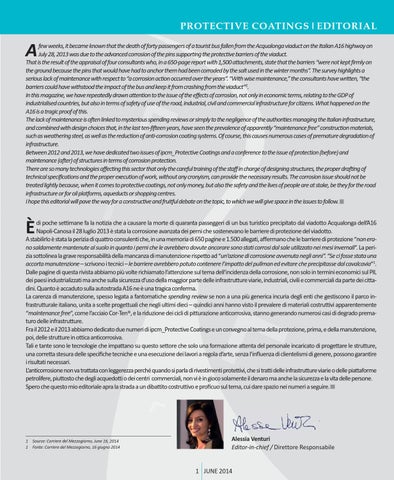PROTECTIVE COATINGS EDITORIAL
A
few weeks, it became known that the death of forty passengers of a tourist bus fallen from the Acqualonga viaduct on the Italian A16 highway on July 28, 2013 was due to the advanced corrosion of the pins supporting the protective barriers of the viaduct. That is the result of the appraisal of four consultants who, in a 650-page report with 1,500 attachments, state that the barriers “were not kept firmly on the ground because the pins that would have had to anchor them had been corroded by the salt used in the winter months”. The survey highlights a serious lack of maintenance with respect to “a corrosion action occurred over the years”. “With wise maintenance,” the consultants have written, “the barriers could have withstood the impact of the bus and keep it from crashing from the viaduct”1. In this magazine, we have repeatedly drawn attention to the issue of the effects of corrosion, not only in economic terms, relating to the GDP of industrialised countries, but also in terms of safety of use of the road, industrial, civil and commercial infrastructure for citizens. What happened on the A16 is a tragic proof of this. The lack of maintenance is often linked to mysterious spending reviews or simply to the negligence of the authorities managing the Italian infrastructure, and combined with design choices that, in the last ten-fifteen years, have seen the prevalence of apparently “maintenance free” construction materials, such as weathering steel, as well as the reduction of anti-corrosion coating systems. Of course, this causes numerous cases of premature degradation of infrastructure. Between 2012 and 2013, we have dedicated two issues of ipcm_Protective Coatings and a conference to the issue of protection (before) and maintenance (after) of structures in terms of corrosion protection. There are so many technologies affecting this sector that only the careful training of the staff in charge of designing structures, the proper drafting of technical specifications and the proper execution of work, without any cronyism, can provide the necessary results. The corrosion issue should not be treated lightly because, when it comes to protective coatings, not only money, but also the safety and the lives of people are at stake, be they for the road infrastructure or for oil platforms, aqueducts or shopping centres. I hope this editorial will pave the way for a constructive and fruitful debate on the topic, to which we will give space in the issues to follow.
È
di poche settimane fa la notizia che a causare la morte di quaranta passeggeri di un bus turistico precipitato dal viadotto Acqualonga dell’A16 Napoli-Canosa il 28 luglio 2013 è stata la corrosione avanzata dei perni che sostenevano le barriere di protezione del viadotto. A stabilirlo è stata la perizia di quattro consulenti che, in una memoria di 650 pagine e 1.500 allegati, affermano che le barriere di protezione “non erano saldamente mantenute al suolo in quanto i perni che le avrebbero dovute ancorare sono stati corrosi dal sale utilizzato nei mesi invernali”. La perizia sottolinea la grave responsabilità della mancanza di manutenzione rispetto ad “un’azione di corrosione avvenuta negli anni”. “Se ci fosse stata una accorta manutenzione – scrivono i tecnici – le barriere avrebbero potuto contenere l’impatto del pullman ed evitare che precipitasse dal cavalcavia”1. Dalle pagine di questa rivista abbiamo più volte richiamato l’attenzione sul tema dell’incidenza della corrosione, non solo in termini economici sul PIL dei paesi industrializzati ma anche sulla sicurezza d’uso della maggior parte delle infrastrutture viarie, industriali, civili e commerciali da parte dei cittadini. Quanto è accaduto sulla autostrada A16 ne è una tragica conferma. La carenza di manutenzione, spesso legata a fantomatiche spending review se non a una più generica incuria degli enti che gestiscono il parco infrastrutturale italiano, unita a scelte progettuali che negli ultimi dieci – quindici anni hanno visto il prevalere di materiali costruttivi apparentemente “maintenance free”, come l’acciaio Cor-Ten®, e la riduzione dei cicli di pitturazione anticorrosiva, stanno generando numerosi casi di degrado prematuro delle infrastrutture. Fra il 2012 e il 2013 abbiamo dedicato due numeri di ipcm_Protective Coatings e un convegno al tema della protezione, prima, e della manutenzione, poi, delle strutture in ottica anticorrosiva. Tali e tante sono le tecnologie che impattano su questo settore che solo una formazione attenta del personale incaricato di progettare le strutture, una corretta stesura delle specifiche tecniche e una esecuzione dei lavori a regola d’arte, senza l’influenza di clientelismi di genere, possono garantire i risultati necessari. L’anticorrosione non va trattata con leggerezza perché quando si parla di rivestimenti protettivi, che si tratti delle infrastrutture viarie o delle piattaforme petrolifere, piuttosto che degli acquedotti o dei centri commerciali, non vi è in gioco solamente il denaro ma anche la sicurezza e la vita delle persone. Spero che questo mio editoriale apra la strada a un dibattito costruttivo e proficuo sul tema, cui dare spazio nei numeri a seguire.
1 1
Source: Corriere del Mezzogiorno, June 16, 2014 Fonte: Corriere del Mezzogiorno, 16 giugno 2014
Alessia Venturi Editor-in-chief / Direttore Responsabile
1 JUNE 2014
